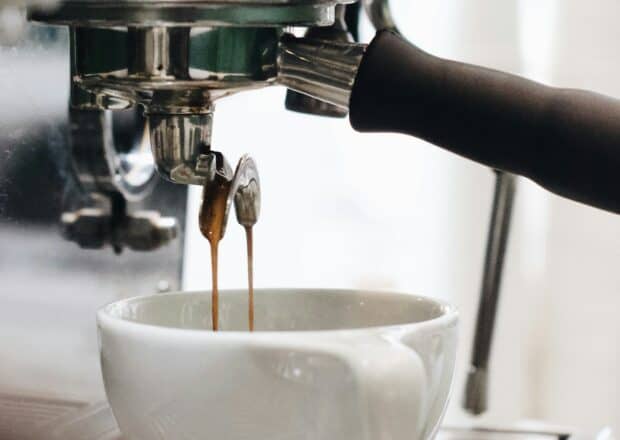Espresso machine drip trays are designed to catch spills of espresso, hot water rinses and backflushes. The liquids and semi-solids then flow from the drip tray into a drain line, where they can create headaches in the form of spills, clogs or unwanted smells.
All of these issues can be avoided with good planning and maintenance, including beginning with a better understanding of the drain line’s purpose and limitations.
Why Are Drain Lines Necessary?
Commercial espresso machines often have condensation and liquid lines designed to flow into the drain line.
These components capture run-off moisture from the steam boiler and steam wand anti-suction valves, the coffee boiler expansion valve and backflushing coffee brew valves. Although designs are not universal, espresso machines often tie these lines together under the drip tray leading to a drain box, as seen below:
Figure 1: A La Marzocco Linea PB 2-group espresso machine drain box. Photo by Ryan Baughn. Diagram by Jon Ferguson.
Why Do They Clog?
When the drain box itself is not draining properly, it is likely due to a restriction of the main drain line (above photo, Figure 1 A.) When puddles are found underneath this area, it may be caused by an overflow of the drain box, or by a drain hose that is improperly fastened.
When your countertop holes are already cut, and there are under-counter coolers placed below the espresso machine, the pathway to the drain may be restricted. In Figure 3 (below), the drain line runs across the countertop to fit through a pre-drilled hole, leading to poor flow.
Figure 3: An example showing insufficient slope and an extra long indirect pathway to the floor drain.
Planning installation with coffee techs and plumbers who are familiar with local code may help reduce these kinds of build-out headaches. Establishing direct contact and installation documents between all parties is ideal.
However, when there is a lack of communication between the plumber and the coffee tech, things can easily go awry. For example, both of the following drain lines (shown in Figure 4 and Figure 5) were installed by professionals.
Figure 4 has a commercial-grade gray drain line fitting loosely into a larger PVC pipe and trap, and properly secured to the wall.
Figure 5 shows a hose made of material that is easily collapsible, attached to a barbed fitting that further restricts flow. There is also no visible air gap in the line, which proceeds to disappear behind a sealed off wall.
Prior to any build out, it is essential to contact local agencies to clarify code. This call can be difficult, since many people fear what requirements inspectors might generate. However, greater costs generally arise following final inspections when owners are required to rip out newly installed plumbing when specs and materials are not up to code.
Keeping it Clean
Matt Campbell, the owner of Invoke Coffee Sales & Service, based in Youngstown, Ohio, suggests a weekly cleaning of the drain box to help avoid build up.
“I like to take some of the Cafiza cleaner in a small cup and mix it up,” said Matt. “Use a toothbrush to scrub the inside of the box and remove debris and coffee into the drain.”
He added, “I then take about 10 ounces of hot Cafiza water and send it slowly down the drain box/hose to keep that drain line clear. Doing this once per week should drastically reduce sediment from building up in the drain box and drain line.”
Another great tip is to use your hot water tap to help break up and flush spills from the drip tray. Using the hot water tap also cycles fresh water into your steam boiler, which is healthy for your machine. Spent cleaning solution resulting from your daily group head backflushing also helps prevent buildup of oils and residue in the drain line.
When there are no alternatives for dumping liquids other than your espresso machine’s drip tray, the viscosity of these liquids and spent grounds will challenge the drain’s performance over time. Installing a dump sink or pitcher rinser within reach of the barista may also help create a better workflow, along with a cleaner drain line.
[Disclaimer: The information provided in this news story is intended for general informational purposes only. The procedures and guidelines described in this story may not apply to all equipment or situations, and equipment installation and maintenance should only be performed by qualified professionals.]
Comments? Questions? News to share? Contact DCN’s editors here.
Related Posts


